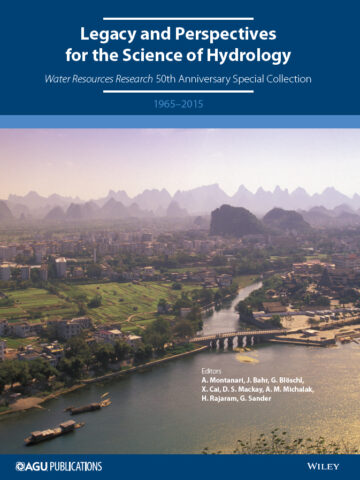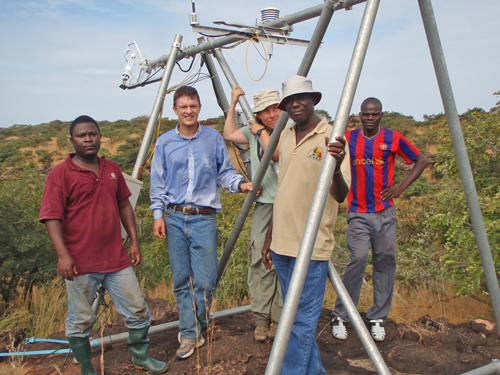In 1965, the American Geophysical Union (AGU) launched a new platform for communicating the work of hydrologists. Since then, Water Resources Research (WRR) has grown into a preeminent source of new scientific insights regarding water systems. The journal covers a range of important aspects of those systems, from technological advancements and research breakthroughs to balancing the competing requirements of water management, societal needs, and sustainability.

To celebrate the fiftieth anniversary, the journal’s editorial board has organized a special section that “looks back on 50 years of research activity and provides a perspective for future research focusing on water systems for the development and benefit of society,” the section’s introduction states.
To mark this major milestone, Eos spoke with current editor in chief Alberto Montanari (University of Bologna), AGU publications director Brooks Hanson, and other members of the WRR editorial board: Jean Bahr (University of Wisconsin–Madison), Scott Mackay (University at Buffalo), and Harihar Rajaram (University of Colorado Boulder).
Eos: What are the most important contributions that WRR has made to hydrology and the scientific community in the past 50 years?
“WRR has always promoted the assessment of this feedback between water, politics, economics, social tensions, societal development, and human well-being.”
Montanari: I would say the main contribution has been to promote an understanding of the links between hydrology, water, and human populations. Humans have an impact on the environment and therefore water—and water impacts us. WRR has always promoted the assessment of this feedback between water, politics, economics, social tensions, societal development, and human well-being. I think WRR has always been an ideal publication outlet, for both young and established scientists.
Eos: What sets WRR apart from other hydrology journals, and how does the journal reflect the broader mission of AGU?
Bahr: I think that what distinguishes WRR, in addition to the high standards it sets for significance of contributions, is the breadth of topics—not only natural science and engineering aspects of water resources but also economics, policy, and management.
Hanson: The Hydrology section is now one of AGU’s largest, and WRR is now one of our largest journals. The journal has grown—and its breadth and scope have grown—as the hydrologic sciences have grown, both in basic research and in covering important and complex issues in society. This intersection is exactly AGU’s mission.
Eos: How do you see the journal contributing to AGU’s mission to nurture the next generation of scientists?
Bahr: The rigorous review process employed by WRR provides these younger scientists with constructive feedback that is designed to help them sharpen their arguments and improve their analytical and communications skills. In my role as an educator of the next generation of hydrogeologists, I use articles from WRR regularly as assigned readings for my students.
Mackay: A very large number of papers published in WRR every year have graduate students, postdocs, and early career scientists as lead authors. I believe the journal is widely recognized within the field of hydrology as the place to publish early to land good postdoc or tenure track positions. Also, as editors, we strongly encourage early-career researchers to publish in WRR. We have held open forums at the AGU Fall Meeting so that young scientists can ask the editors questions about how to get published, how the review process is conducted, etc. We welcome queries from authors on ideas for papers, as we can advise them on any dos and don’ts.

Hanson: The hydrology section has helped start a student conference immediately before the Fall Meeting and developed an “AGU Water” Facebook page. WRR editors and AGU staff are actively engaged in those initiatives. Our surveys have shown that students, in particular, value AGU publications for their quality and reach. We are working to expand the diversity of our editorial teams and have that as a priority, and we’re also starting a series of author and reviewer workshops and webinars and other educational efforts—for example, around data management—to help engage early-career and international scientists.
Eos: As the journal evolves, what excites you about being an editor?
Rajaram: Just the breadth of new themes reflected in the papers we’re getting. WRR is coming back to its roots, where we’re trying to integrate the science side and the management side, [as well as the] society and social development side. It’s a pretty exciting time.
Montanari: In 2015, we are going to get about 1700 papers. It really is a privilege—I have the opportunity to gain a very broad picture. And this special section is really exciting—this is the second special section celebrating an anniversary. The first was in 1986 to celebrate the twentieth anniversary [actually celebrated in the journal’s 21st year], and it was a milestone; people are still reading those papers. I have the ambition that this special section will be a milestone like the previous one. You can see an impressive collection of contributions, and they are all new discoveries, new papers, giving an exciting picture for the future of scientific research.
Eos: What do you see as the main goals for WRR looking ahead for the next 50 years? How do you define or envision success?
WRR is one of our largest journals, and submissions continue to increase at about 10% per year.
Hanson: I think WRR is already extremely successful. It is one of our largest journals, and submissions continue to increase at about 10% per year. The editors have also started a “Debates” series to further highlight some of the complex scientific and societal issues touched on by the research papers it publishes. We expect that the journal will continue to grow and present important research in the hydrological sciences.
Montanari: This special section is entitled “Legacy and Perspectives.” The idea of giving it this title was to emphasize that on the one end, we have this legacy, this tradition, and, on the other end, we need a new vision. I think the legacy is extremely important, but at the same time, we need to work from a local perspective to a global perspective. In the past, water management took place at the catchment scale; nowadays, our hydrology needs to look at the big picture. I think this is the challenge for the next 50 years—our perspective should be global.
—Lily Strelich, Freelance Writer
Citation: Strelich, L. (2015), Water Resources Research at 50: Journal’s lasting impact expected to grow, Eos, 96, doi:10.1029/2015EO037651. Published on 20 October 2015.
Text © 2015. The authors. CC BY-NC 3.0
Except where otherwise noted, images are subject to copyright. Any reuse without express permission from the copyright owner is prohibited.

